Organising
How to organize a small kitchen
If you’re an organized person, keeping your small kitchen clean and tidy should be a doddle. For the rest of us, the struggle is real. My kitchen doesn’t stay clean long with two kids, two cats, and a very messy spouse! In this post, I will show you how to organize a small kitchen without a pantry to enable you to prepare food safely and quickly and help you make your kitchen the perfect place to relax and eat.
This post will discuss how to simplify and organize your kitchen for good, using my simple-to-follow rules for decluttering and organizing the kitchen. We will discuss storage solutions, organization ideas, and ways to create more storage space in your kitchen cabinets.
It can be challenging to find the motivation to declutter and clean, particularly in areas with a lot of items, such as the kitchen. It’s crucial to know how to organize a small kitchen without a pantry and create a clean and clutter-free counter space, which is more critical than in other areas of the home. A cluttered and disorganized kitchen can make preparing meals and finding ingredients challenging, ultimately adding unnecessary stress to your daily routine.
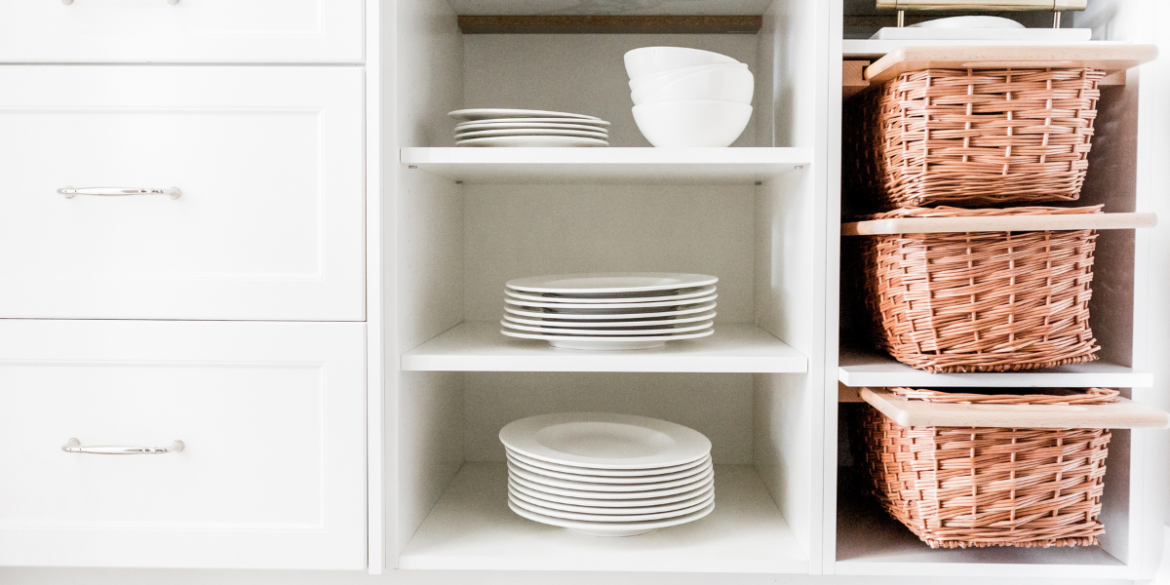
Why it is so important to keep your small kitchen organized.
The kitchen is the most important place in the house to keep clean, organized, and clutter-free.
- To prevent cross-contamination and the spread of bacteria such as E. coli and Salmonella.
- The kitchen is a high-traffic area that needs to run smoothly and efficiently to prevent chaos and disruption.
- A kitchen has potentially dangerous equipment, chemicals, and tools, so safety and good kitchen organization are hugely important to prevent scalds, burns, trips, and falls.
- The kitchen is often the hub of the house, where people gather to eat and socialize. Therefore, it needs to be a calm, organized environment where people feel at home and relaxed.
I have a very small kitchen with limited space. There are only four cupboards, three drawers, and one small countertop, so storage is a big issue. To make things worse, I am really into kitchen gadgets, which makes it even more challenging.
This post contains affiliate links, and The Organizer UK may earn commissions for purchases made through the links in this post. For more details, see here. Thank you so much for your support!
How I Organize My Small Kitchen
I use my kitchen cabinets as a pantry to maintain an organized kitchen. This is achieved by limiting the number of kitchen gadgets, cutlery, utensils, and crockery to the bare minimum. I do not keep duplicates; everything in my kitchen serves multiple purposes.
- Ninja Foodi: used for slow cooking, air frying, steaming, pressure cooking, grilling, sauteing, and much more!
- Blender: used for smoothies, milkshakes, soups, and baking.
- Toaster: used for breakfasts, lunches and dinners
- Two steak knives
- Wooden spoon
- Pizza cutter
- Garlic press
- Multipurpose knife
- Eight knives, forks, spoons, and three teaspoons (the other five were thrown in the bin by my 5-year-old each time he’d finished his yogurt!)
- Measuring spoons: which double up as serving spoons
- Tin opener: doubles as a bottle opener
- Scissors
- Fish slice
- Potato and vegetable peeler
- Spatular
- Four pans: Doubles as a steamer
- Oven tray
- Casserole dish: doubles as a pie dish
- Lasagne tray: Doubles as an oven dish
- Frying pan
- Muffin tray
- 1 cake tin
- Drinking bottles (stainless steel)
- Cats dishes (stainless steel)
- Glasses: six
- Six mugs
- Eight plates, side plates, bowls
- Cleaning products (my weakness)
- 1 mixing bowl
- 1 salad bowl: doubles as a fruit bowl
- 1 colander
Most of these items are multi-purpose, replacing single-use gadgets and saving space and money.
Despite having only a few gadgets and limited storage, my space is organized and easy to navigate. The kitchen counters are free of clutter.
Organizing a small kitchen can be daunting, especially if downsizing.
If you check my kitchen utensils, you’ll see that I don’t have many unused items. Most of my possessions are multifunctional.
For example, if you are struggling with kitchen storage, it’s not ideal to purchase a tool that has only one use, such as a pineapple slicer. Other examples include:
- Strawberry hullers
- Cherry pip removers
- Avocado keepers
- Mango slicers
- Potato ricers
- Waffle makers
- Pie makers
- Cupcake makers
- Omelet makers
- Popcorn makers
One of the crucial things to keep in mind to stay organized in a small kitchen is to have multifunctional items.
When I open my kitchen drawer, I can easily find my favorite knife without rummaging through a bunch of unused stuff.
After you have organized, cleaned, and tidied up your kitchen, it’s important to establish a system that will help you maintain its cleanliness and organization. By following these guidelines, you should be able to keep your kitchen in order, and cleaning it will become effortless.
Get rid of:
- Duplicates
- Unused gadgets/ utensils /baking trays
- Broken items
- Out-of-date food
- Unused food (food bought on a whim which is very unlikely to be eaten)
- Decorations and nic-nacs
- Cookery books (unless used frequently, then please store them on the bookcase with other books) to discover how to declutter cookery books, read this post.
Clean the kitchen thoroughly.
- Look at your space and decide what to store in each area for convenience. For instance, put the pans near the cooker and keep the cups near the kettle.
- Items used infrequently go at the back of the cupboards or on high, more challenging-to-reach shelves.
- Keep plates, glasses, and cutlery near the dishwasher, as these are washed more often than other items, making it easier to put them away when emptying the dishwasher.
- Store washing powder next to the washing machine.
- Keep everything off countertops and windowsills.
- Do not over-stack shelves. Otherwise, keeping them clean and organized is harder.
- Decorative items are not for the kitchen as they get greasy and dusty, which makes it harder to keep the kitchen clean and tidy. Save the decor for somewhere else if you must!
Declutter and Organize food
Keeping track of food can be difficult. Items often expire and get lost in the fridge and cupboards.
- Don’t overstock and hoard food. If you’ve not got loads of stuff in your cupboards, it is easier to see what you need to buy next time you shop.
- Use a grocery list like this one to help combat food wastage when you shop.
- Get rid of any food you don’t use regularly.
- Put lesser-used food toward the back of the cupboards.
- Ensure everything is sealed and labeled (I use a label maker like this one) after opening to prevent spillage and avoid attracting ants and other pests.
- Bring stock forward and place new items behind the older ones when you unpack the groceries.
- Wipe the bottom of jars after use before putting them away, as it will keep your cupboards cleaner for longer.
- The fewer items you keep in your cupboards, the easier to see what you’re running out of. Don’t be tempted to hoard food you never use; avoid impulse food shopping.
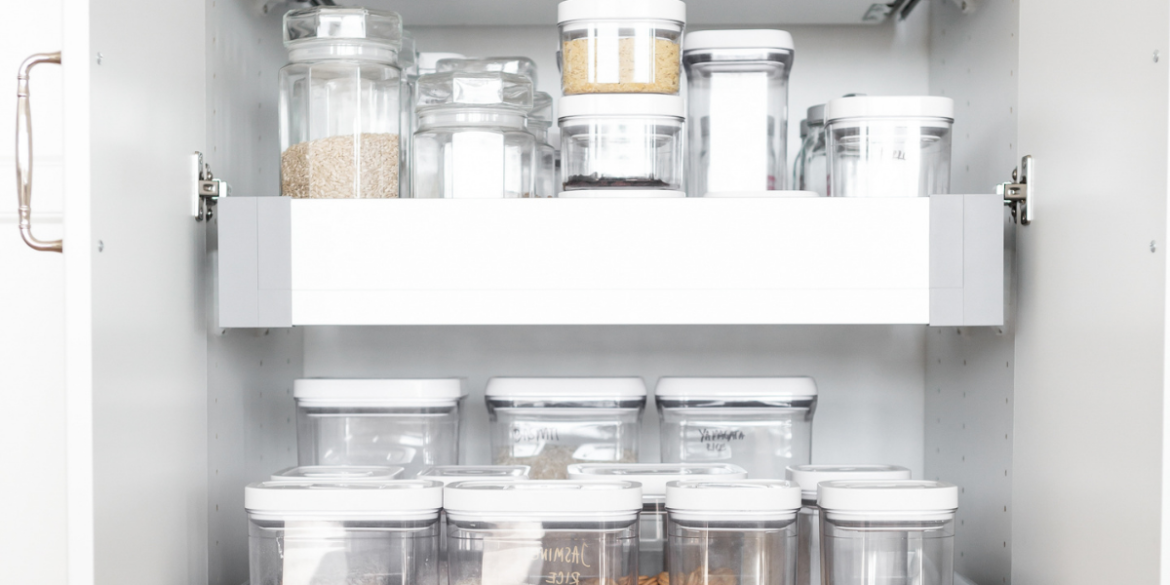
Get rid of the junk drawer.
If you have a junk drawer in your kitchen, it can attract clutter and take up much-needed storage space. But don’t worry, I have some tips on how to get rid of it. Check out my article on how I got rid of my own junk drawer. Once you’ve sorted everything out and put things in their proper places, you’ll have an empty drawer that you can use for pantry storage. This is a great spot for spices, dry goods containers, or other pantry items.
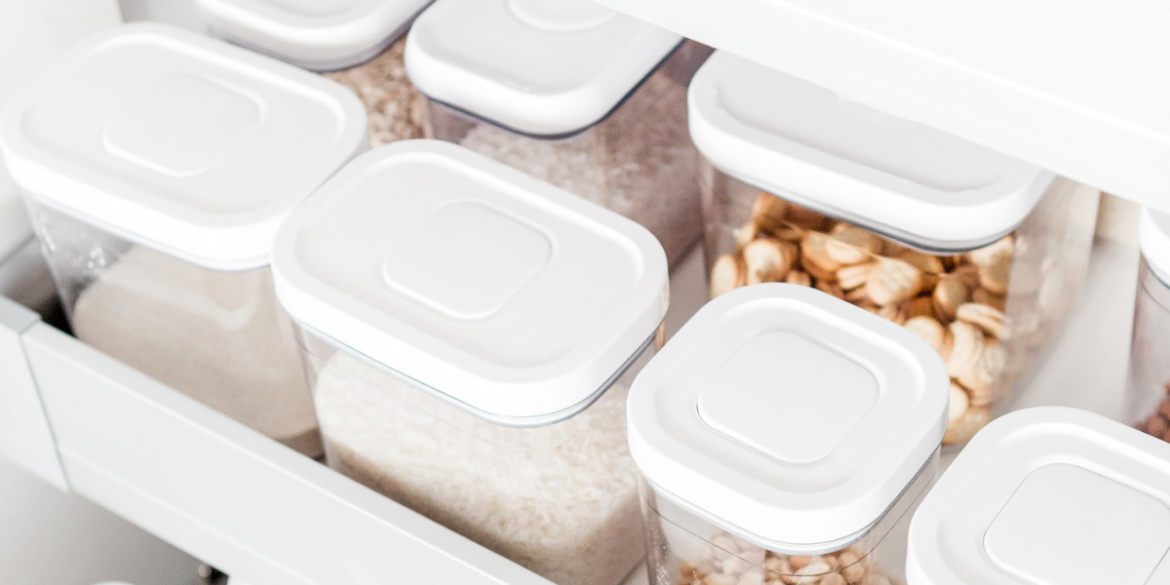
Store utensils and baking trays vertically
One of the biggest challenges in keeping a kitchen organized is finding efficient ways to store utensils and trays. Often, we find ourselves digging through cluttered drawers or cupboards just to find that one spatula we need.
But what if there was a way to make accessing your utensils and trays easier while also saving space? Well, storing them vertically instead of horizontally may just be the solution you’ve been looking for.
By storing utensils and trays vertically, whether it’s on a wall-mounted rack or using dividers in a deep drawer, you can easily see and access each item without having to dig through a pile. This not only saves time but also eliminates the frustration of constantly searching for the right tool.
Moreover, storing items vertically also allows for more efficient use of space. Rather than taking up valuable drawer or cupboard real estate, the wall-mounted rack or dividers can be installed in an otherwise unused area. This frees up more space for other kitchen essentials and reduces clutter.
But why stop at just utensils and trays? Vertical storage can also be applied to larger kitchen items such as cutting boards and baking sheets. By using a file organizer or tension rod in a cabinet, these items can be neatly organized and easily accessible without taking up too much space.
In addition to saving time and space, vertical storage also promotes better organization. With each item having its designated spot, it becomes easier to maintain order in the kitchen. No more shuffling through stacks of pans or digging through drawers trying to find that one specific utensil. With vertical storage, everything is visible and within reach.
And it’s not just limited to the kitchen. Vertical storage can be applied to other areas of the house as well, such as closets or office spaces. In a closet, hanging shoe organizers or pegboards can be used for storing accessories like scarves and belts. In an office, wall-mounted shelves or magazine holders can keep paperwork organized and off the desk.
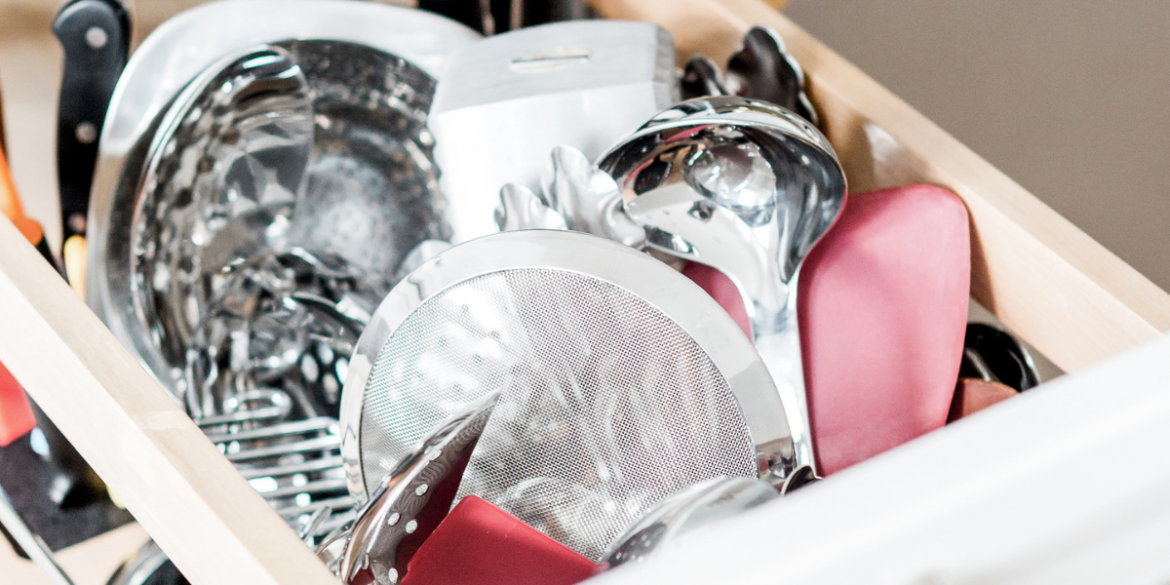
Make use of wall space.
If you want to create more space in your kitchen cabinets, consider displaying some of your attractive crockery on shelves. Keep this in mind when you go shopping for crockery and only buy items that are both aesthetically pleasing and useful. White crockery is always a good choice because it looks great on display and does not clutter up your kitchen. Additionally, consider investing in stackable or space-saving crockery to maximize the use of your cabinets.
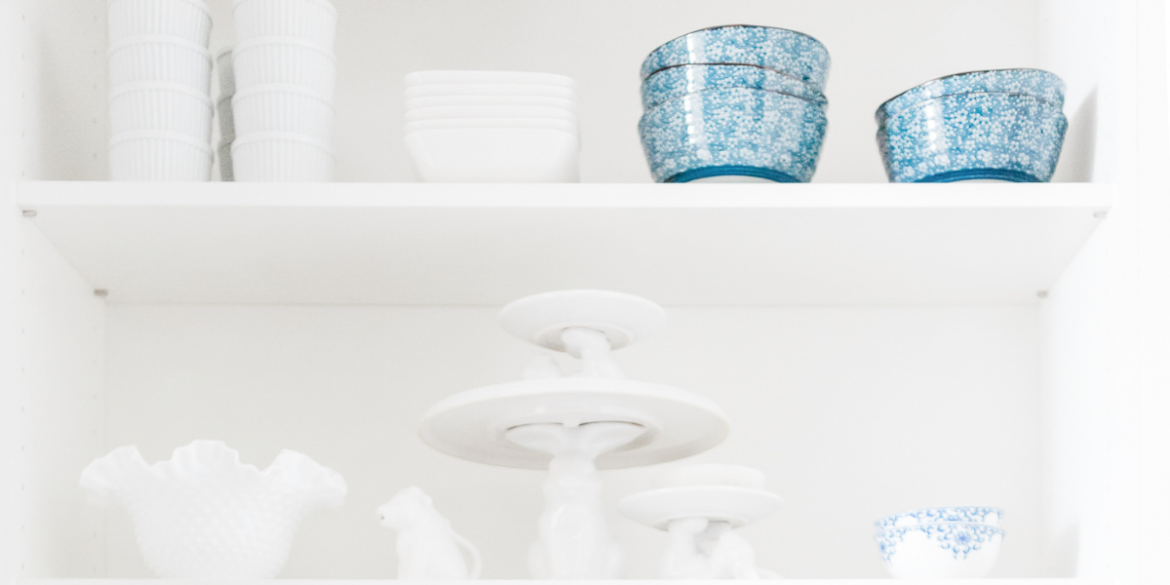
Use the tops of the cabinets.
A great way to create a pantry in a small kitchen is to use slim storage solutions. You can easily fit them into any gaps that are not being used. These storage solutions are perfect for storing spices, tins, pet food, and cleaning products. This not only saves space but also helps keep your pantry organized and clutter-free. One option for slim storage solutions is to use a pull-out pantry. These are narrow shelves that can be pulled out from a cabinet or wall, allowing you to easily access items at the back. They are especially useful in tight spaces where traditional cabinets may not fit.
Use the back of the kitchen doors.
One popular idea to organize a small kitchen is to use a door storage system. This system is sturdy enough to hold pantry items like dried goods, tins, and cleaning products. It also maximizes vertical space, making it perfect for small kitchens with limited counter and cabinet space.
One way to implement this system is by using over-the-door racks or shelves. These can easily be installed on the back of your pantry door or a cabinet door. You can store commonly used items like spices, oils, and condiments here for easy access while cooking. This not only saves you valuable counter space but also keeps these items organized and within reach.
Another option is to use an adjustable wire rack that hangs from the top of your cabinets. This versatile solution allows you to customize the height of the shelves to fit your needs and stack items in a neat and organized manner. It’s perfect for storing bulky items like pots, pans, and baking sheets that would otherwise take up precious cabinet space.
Use a corner pantry.
If you have an unused corner in your kitchen, you could use a corner pantry to create more storage space. Corner pantries are a great solution for small kitchens as they utilize the often overlooked area of a room. Not only do they provide extra storage, but they also add visual interest and can be customized to fit your specific needs.
When it comes to choosing a corner pantry, there are a few things to consider. First, think about the size and layout of your kitchen. Measure the space you have available in the corner and make sure that your chosen pantry will fit comfortably without obstructing any doors or walkways.
Next, think about the style and design of your pantry. You can opt for a traditional cabinet-style pantry with shelves inside, or you could choose a more modern option such as open shelving or pull-out drawers.
Use free-standing pantry alternatives.
If you’re looking for extra storage space in your dining room or living room, consider using a discreet free-standing kitchen pantry. These pantry cabinets are designed to fit seamlessly into any room, providing you with ample storage space without taking up too much floor space.
One of the great things about free-standing kitchen pantries is their versatility. They come in a variety of sizes and styles, so you can choose one that fits your specific needs and aesthetic preferences. Some have shelves for storing canned goods and dry goods, while others have drawers for organizing smaller items like utensils or spices.
In addition to providing extra storage space, a kitchen pantry can also serve as a stylish accent piece in your home. With options ranging from sleek modern designs to rustic farmhouse styles, there’s sure to be a pantry that complements your existing decor.
Get rid of all the books in your kitchen
It’s difficult to clean around recipe books, and they take up valuable space. Additionally, they attract dust and grease. Visit this link provided to learn how to declutter your recipe collection.
Recipe books are a staple in many households, containing family favorites and treasured recipes passed down through generations. However, as much as we love our recipe books, they can quickly become overwhelming and take up valuable space in our kitchens.
Deal with the dishes after every meal.
It’s important to clean dirty dishes as soon as possible to avoid clutter in the kitchen sink. Leaving dirty dishes in the sink can attract pests, create unpleasant odors, and make it difficult to use the sink for other purposes.
Keep paperwork out of the kitchen.
When it comes to keeping a tidy and organized kitchen, one of the first things to consider is the amount of paperwork that tends to accumulate. From bills and receipts to coupons and flyers, it can be easy for paper clutter to take over your kitchen space.
To avoid this, it’s important to keep all paperwork out of the kitchen unless you have a designated workstation in there specifically for dealing with paperwork. This will help keep your countertops clear and prevent papers from piling up on various surfaces.
Instead, try setting up a desk or small workspace in another room where you can address all your paperwork. This could be a spare room, home office, or even just a corner of your living room. Make sure this area has enough storage solutions to deal with the paperwork clutter.
Refrain from sticking objects on the fridge door
A helpful tip for keeping your fridge clean is to keep it clutter-free. As a professional cleaner, I find fridge magnets to be a common issue. If you’re using them to hold paperwork, consider finding a new system to organize your papers. If you’re using them for decoration, make sure to place them in a spot where they won’t collect grease or impede cleaning. By keeping your fridge clutter-free, you’ll make it easier to keep your home clean and tidy!
Ensure that the bin is emptied every day.
It’s important to empty the bin daily, even if it’s not full. This prevents family members from stacking things on top of it and keeps flies and bad smells away.
Create and maintain a consistent daily routine.
A daily routine can help you stay on top of your daily tasks. It can provide structure and organization to your day, allowing you to be more productive and efficient. We understand the importance of a daily routine and offer tools and resources to help individuals create and stick to one.
When creating a daily routine, it’s important to consider your own personal preferences and habits. Some people work better in the morning, while others are more productive in the afternoon or evening. Take some time to figure out when you are most focused and motivated, and plan your tasks accordingly.
Keep the surfaces clutter-free at all times
It is quicker and easier to clean up after every meal if the surfaces are clutter-free. The bonus is that your kitchen will always look immaculate if you follow this rule. Store toasters, utensils, and kitchen gadgets in cupboards and out of sight. This tip helps me keep my house clean in a super-fast time.
Keep the fridge organized.
- It’s best to go grocery shopping after cleaning out your fridge; this helps you use up leftovers and make space for fresh food.
- Use your blender to use any fruit and vegetables; this can then be frozen and added to stews, casseroles, pasta, or curry sauces as needed.
- Keep a basket in the fridge for food for packed lunches, such as yogurt tubes, fruit, cheese, and spreads ( portioned in easy-to-grab bags for speed in the mornings.)
- Use a chalkboard to write down the use by / best before dates of fresh food going into the fridge, so when meal planning, you can use shorter-dated food first at the beginning of the week.
Congratulations, you’ve taken the first steps to organize your home! For further reading on cleaning, read my post How To Get Motivated To Clean When You Are Overwhelmed By Housework.
If you have any questions about organizing a small kitchen or have any tips to share, let us know in the comments!

